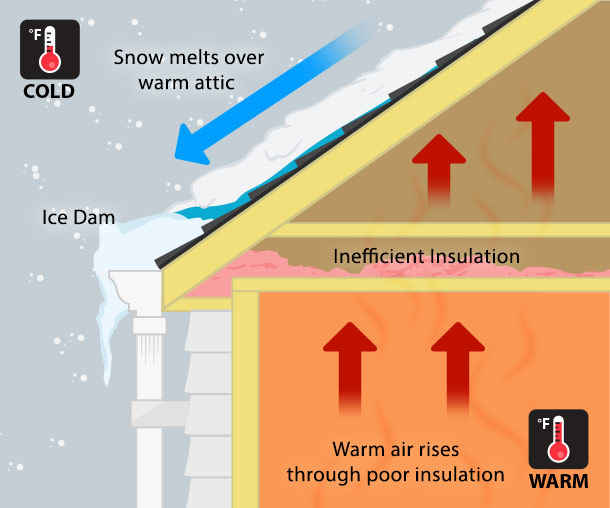Quality matters when hiring for a big project. Call a Best Pick now!
When your neighborhood gets blanketed with snow, you may get to enjoy some time outside with your family, take in the beautiful scenery, or even indulge in a day off from work. But snow brings its fair share of hazards to go along with the fun.
Many homeowners experience ice dams along their roofs, which are a danger to people on the ground and can damage your roofing system.
What Causes an Ice Dam?

Poor insulation can mean wasted money on energy bills, but it can also cause costly roof damage. An ice dam forms as a result of air leaks and insufficient insulation in an attic.
To avoid ice dams, your attic should be roughly the same temperature as the outside air. If an attic is too warm, accumulated snow will melt and trickle off the roof. When the water meets the eave (or overhang), it will refreeze, form icicles, and eventually pile up in a dam.
These dams can force moisture underneath the shingles, inviting mold growth, wood rot, and roof leaks.
Prevention
While there are a few ways to treat ice dams once they have formed, the best practice is to prevent them altogether. If you have previously experienced problems with ice dams or are worried about them developing in the future, consider doing the following:
- Replace any damp insulation caused by roof leaks.
- Add additional insulation. Depending on what insulation materials you use, ENERGY STAR recommends that attics be insulated to a level of R-38, or 10 to 14 inches of loose fill.
- Locate and seal any leaks in the ductwork. For more information, read our article on identifying and treating leaking ducts.
- Locate and seal any attic leaks. Just like an old air filter, dirty insulation is usually a good indication that air has been moving through it. Air can also leak through dryer vents, duct registers, and dropped soffit areas.
- Leaks can be difficult to identify, so consider hiring an energy auditor to perform a comprehensive assessment.
- Address attic ventilation issues with your roofing contractor. A well-designed ventilation system can expel moist air and even out temperature differences between the outside air and the underside of the roof.
- Have a gutter professional clean and tune up your gutters before freezing temperatures arrive to avoid any additional ice buildup.
Treatment Options
Do not attempt to chip away at an ice dam. Not only will breaking up the ice damage your roof and worsen an ice dam problem, but it’s also extremely dangerous for homeowners to work on roofs, even in ideal conditions.
When ice is present, the risk of injury increases significantly. Before ice accumulates, you can remove snow with a roof rake, but this is only recommended when you can safely reach the snow from the ground level.
If you experience frequent ice dams, a self-adhering protective membrane can be applied to the roof deck in place of typical underlay material to help stop leaks.
The National Roofing Contractors Association (NRCA) recommends applying a protective membrane to homes that experience an average temperature of 30 degrees or less during the winter.
According to the NRCA, this membrane should extend 24 inches upward from the point where the exterior wall meets the roof. Roofs with a slope of 4:12 or less as well as homes that experience very heavy snowfall may require 36 inches of coverage.
Ice dams can be a frustrating problem, but they can thankfully be treated and even prevented.
A roof is a major investment, so avoid costly repairs by following the recommendations detailed in this article prior to the first winter freeze.


























